HP Stream 11 Review: A New Take On Low Cost Computing
by Brett Howse on December 17, 2014 8:00 AM ESTBattery Life
Sub $500 Windows laptops have notoriously had poor battery life, despite their massive size. HP claims over eight hours of battery life for the HP Stream 11. It is helped out by a low power CPU in the Celeron N2840, which has a maximum TDP of only 7.5 watts, and a SDP of 4.5 watts. The display is also fairly easy to drive, with a low resolution and a low pixel density.
In order to keep our results consistent, the display is normally set to 200 nits. The HP Stream is an exception to the rule though because the dimming circuitry is clearly as low cost as the rest of the device. Normally, a Windows laptop can have the brightness adjusted from 1 to 100% in 1% increments in the advanced power settings. The HP Stream 11 though only goes up or down by 10% at a time. It can be set for 91%, but the display output is exactly the same as 100%. At 100%, the display was 220 nits, and at 90% it was 185 nits, so for the battery tests I used the latter number since it was closer to 200. Just to ensure it was not unfair to run slightly dimmer than normal, the tests were repeated at 100% brightness and the results were within a few minutes of each other.
In addition, most Windows devices have an automatic setting to hibernate at 5% battery power, in order to avoid damaging the lithium-ion battery. Li-Ion batteries will stop functioning altogether if the voltage drops too low across the cell, which can cause internal damage to occur to the battery rendering it useless. Normally then, our battery tests are testing the 0-100% useful span of the battery, which is generally 5-100%. In the case of the HP Stream 11, the lowest possible setting before it hibernates is 9%, meaning almost 10% of the battery capacity is not available to the end user.
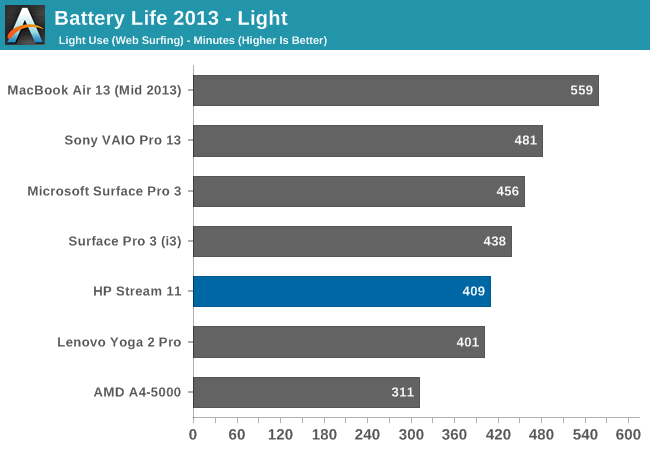
In our light browsing test, the HP Stream 11 managed almost seven hours of runtime, which is a decent result. With just a 37 Wh battery (of which we only get 91% of it) it actually has a smaller battery than a tablet like the Surface Pro 2.

For our heavy test, we ramp up the web browsing, download a file at 1 Mbps, and watch a video. This shifts more of the power usage to the CPU and other components from the display, which can be the main draw in the web test. Here the Bay Trail CPU does very well, outperforming devices with much larger batteries, and setting the best battery life time we have seen yet from this test. Our online comparison tool, Bench, does not contain any other laptops with Bay Trail though, so it is competing against much higher TDP parts. Still, with a heavy workload, the device lasted just under an hour less than the light workload test, which shows the efficiency of the processor.
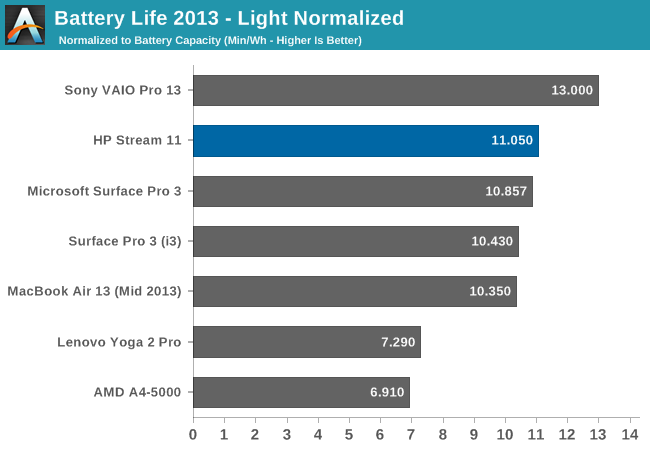
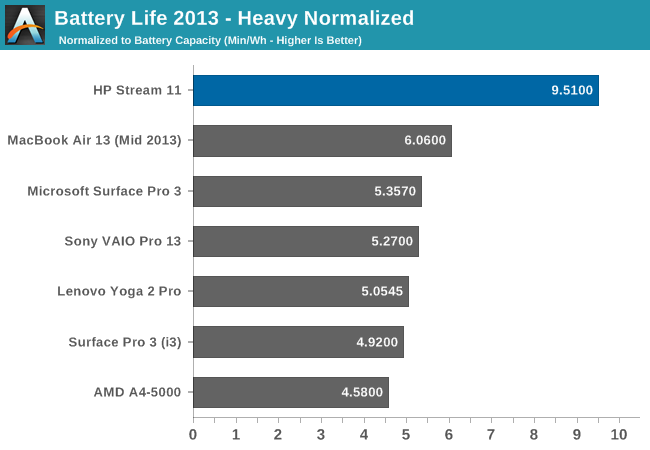
To see the overall power efficiency with the battery size removed, we like to show a normalized graph as well. On our light test, the HP Stream 11 is quite close to the top. It does not meet the incredibly power efficient package that Sony put together for the VAIO Pro 13, but the Bay Trail based Stream 11 does do very well. On our Heavy normalized result, the Bay Trail based Stream 11 shows why it has a place in Intel’s lineup. While performance is obviously lower than the Core parts, overall efficiency is very high.
Temperatures
With no fan at all, one may be concerned that the HP Stream 11 may get warm under heavy use, but as we saw in the heavy normalized graph, the CPU architecture is very efficient.
HP Stream 11 (Idle)
HP Stream 11 (100% CPU/GPU load)
Idle temperatures on the CPU were around 41° C, with a power draw of 0.57 watts. Putting the device under sustained load did not cause a huge spike in temperatures despite the lack of active cooling. The peak temperature seen on the CPU after about ten minutes of 100% CPU and GPU load was only 65° C. Power draw was around 4.33 watts, so the turbo functions of the design are keeping it within the Scenario Design Power rating of this CPU of 4.5 watts. The outside of the device never gets warm either.
Charging
HP supplies a 45 watt charging adapter with the Stream 11. The maximum charge rate when the battery is almost depleted is about 18.3 watts, which leaves plenty of adapter power to keep the rest of the system going while charging the battery.
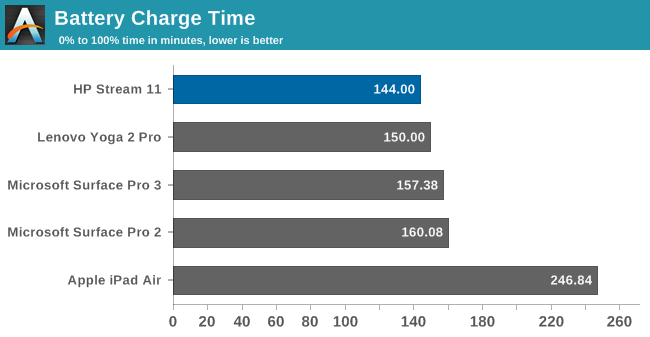
The HP Stream 11 can fully fill the 37 Wh battery in just under 2.5 hours, which is the shortest in our admittedly limited sample size.
Speakers
There are stereo speakers on the Stream 11 but they are downward firing. The outright volume on the speakers is fairly reasonable, with a maximum SPL of 86 dBA when playing music. As with most laptop speakers, the physical size and location of the speakers will never result in great quality audio despite the DTS Studio Sound label on the device.
Small speakers facing underneath the device is never going to give a great result. There is almost no sound at all under 200 Hz, and the response curve is not very smooth. While there will be no issues for voice chat, music playback and movies would be better suited to headphones.


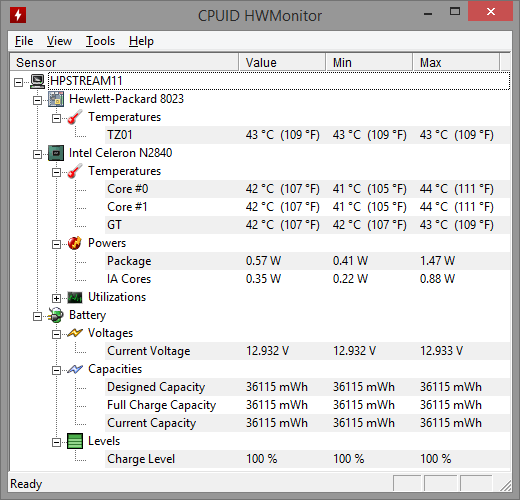
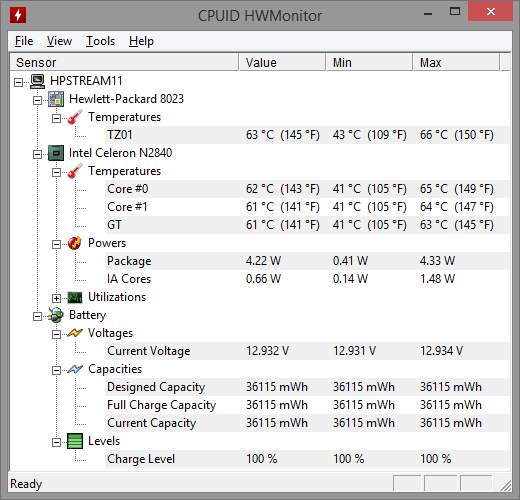
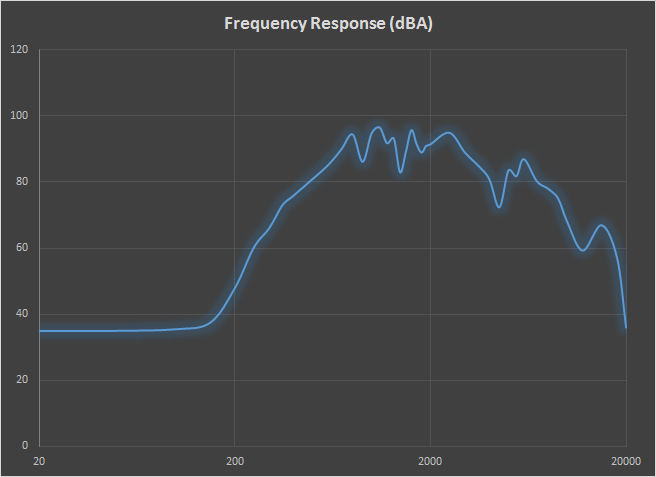








59 Comments
View All Comments
name99 - Wednesday, December 17, 2014 - link
It's interesting to compare against the iPad Air 2 which,for most benchmarks, comes out as 1.5 to 2x as good.I say this not as a "rah rah Apple" --- an iPad Air 2 is about 3 to 4x the price of this thing --- but more as a "who says ARM isn't appropriate for laptops?" I'd want rather more oomph from my laptop, which I run Mathematica on, but there certainly appears to be a market for which ARM levels of performance are acceptable. Which means hurdle number one has been overcome...
There are some remaining hurdles...
We need an OS. Ubuntu probably ain't gonna cut it. God knows what the new, panicky and flailing, MS will do. They could offer up Windows RT for this class of devices. Or is Win RT dead and buried? Chromebooks may continue their slow burn trajectory --- I don't think anyone can predict how those will play out.
And we need a CPU. Snapdragon 810 seems to be MIA for a few more months (and who knows how it will perform when it ships). The server level CPUs seem very inappropriate. But Denver is a serious possibility, and Samsung may one day ship an A57 Exynos that isn't embarrassing.
So I could see Chromebooks firing back with equivalent level HW, and higher performance in the form of a Denver CPU.
If Google could then get its head out of its ass long enough to
(a) make a deal with Citrix for a Citrix front end on Chromebooks that doesn't absolutely suck (one star on the Chrome Store! that's some fine going, Citrix!)
(b) get Android apps (pretty much all of them) to run on Chromebook
they might have a product that catches fire.
(But WITHOUT BOTH of these, I suspect they're relegated to the "meh, interesting but not for me" category.)
savagemike - Wednesday, December 17, 2014 - link
ChromeOS does not exactly restrict you to Google's ecosystem. And while this might have more onboard storage than typical ChromeOS devices - the paradigm is a bit different for ChromeOS. Onboard storage is not as necessary as it has traditionally been on Windows.Mobile-Dom - Thursday, December 18, 2014 - link
Is the Wireless card Mini PCIe? or is it soldered down? because im sure you can find 802.11ac Mini PCIec cards on ebay for like £25Brett Howse - Thursday, December 18, 2014 - link
Although I didn't crack mine apart, I believe it's mini PCI-E from what I could find.Yes, you should be able to change it, but that doesn't excuse the one put in there. Also when you're dealing with something with a $200 price point, saying "just add a better card yourself" and it's $30 means that you are now 15% over the original asking price. That's a lot. Add in a new wireless and a good SD card and you're going to be closer to $300 that $200 and then your options for other devices increases.
jabber - Thursday, December 18, 2014 - link
Well when I look at a customers laptop and I mention "Oh it's got Wireless N!" to a customer they will always say "what's that?"You spec according to the average Joe.
amdhunter - Thursday, December 18, 2014 - link
The wireless is horrible. I knew it was 1x1 when I bought it, but didn't expect it to be as bad as it is. It took a lot of playing around with my router to get around all the interference in my area, but most of the time I am tethered to my gigabit Ethernet adapter so it doesn't bother me much.From the breakdown manual, you can replace it, but I don't know if HP still blacklists cards or not.
greenwavelet - Wednesday, January 7, 2015 - link
The Stream, doesn't have Ethernet according to the specs.Are you using a USB3 Ethernet adapter for this?, you're still not getting anywhere near Gigabit speeds, not to mention you lose the single USB3 port for other devices (backup drive...)
This looks like a reasonable laptop as a standalone PC, but not suitable for any networking use more than browsing.
MrSpadge - Thursday, December 18, 2014 - link
Surprisingly good. Move to an IPS screen, quad core CPU (with silent fan) and 64 GB of NAND and it should easily sell for ~250$, with better WiFi and higher resolution maybe even 300$. It would be nice to have both options.Lolimaster - Thursday, December 18, 2014 - link
Considering that i get 60-90fps in league of legends with good old amd 790gx (2008) integrated gpu @1024x768 medium/high details, how bad can be intel graphics?Morawka - Friday, December 19, 2014 - link
its a shame none of these stream books have RJ 45 Ethernet. This is a perfect low cost laptop to use in the field fixing routers, AP's, and other networking gear.ATM i'm using a venue 8 pro with a USB OTG ethernet adapter. It's a pain in the ass to lug all that stuff around but it'll have to do until someone makes a decent laptop with RJ45 priced $200 or below